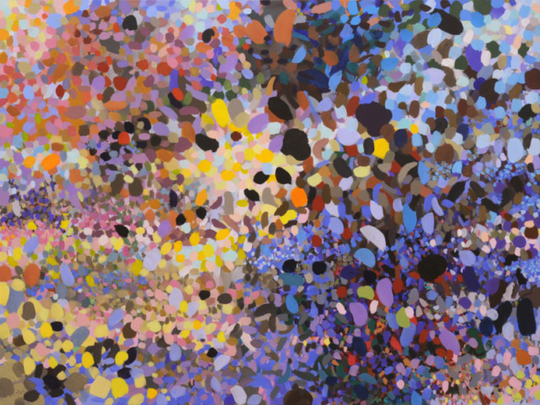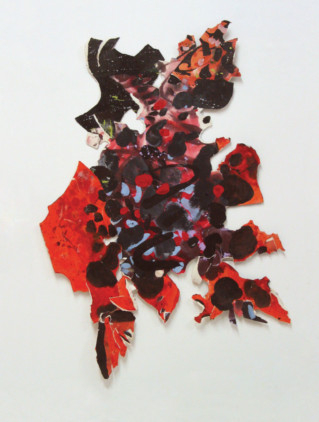
Ayyam Gallery is celebrating New York-based Palestinian artist Samia Halaby’s illustrious career with the first major retrospective of her work, “Samia Halaby: Five Decades of Painting and Innovation”. The show, curated by art historian Maymanah Farhat, features paintings, drawings, silk-screen prints, stone lithographs, computer-generated kinetic works and hanging sculptures, representing every stage of the 78-year-old artist’s journey, and her creative experiments with new materials and technology. It traces Halaby’s attempts to examine and communicate physical properties as they are experienced in reality through the visual language of abstraction.
Halaby was born in Jerusalem, grew up in Jaffa, and moved to the United States in 1951 after her family was forced to leave Jaffa in 1948. After receiving a bachelor’s degree in design and a masters in fine arts, she has taught at universities across the US, and was the first full-time female associate professor at the Yale School of Art. She has been actively involved in the art scene in the Middle East through exhibitions, teaching residencies, and research projects, and is a scholar and promoter of Palestinian art. Her book “Liberation Art of Palestine: Palestinian Paintings and Sculpture in the Second Half of the 20th Century” is considered a seminal text of Palestinian art history, and her research and moving drawings of the Kafr Qasem massacre have documented and drawn attention to the injustices suffered by Palestinians. The retrospective traces her journey from her student days in the American Midwest to New York, where she has lived since 1972, and her engagement with Islamic abstraction as well as seminal modern art movements in the West. It also highlights her position as a pioneer of contemporary abstraction in the Arab world.
The journey begins with some “abstract colour” studies from 1963, when Halaby decided to free herself from the influence of her professors and find her own vocabulary. A series of “Geometric Still Life” paintings represent a turning point in her career, when she noticed a tiny still-life detail of an orange on a window sill, in a classical renaissance painting, and embarked on a scientific examination, using physical models of geometric shapes to understand relationships between light and colour that create depth, volume and movement of a three-dimensional object on a two-dimensional surface.
In 1966, Halaby travelled to Turkey, Egypt, Syria and Palestine, returning with a renewed appreciation and understanding of Islamic art and architecture. The influence of Islamic geometric abstraction can be seen in the “Helixes and Cycloids” segment of the show, and in her textured paintings inspired by the marble inlays in the Dome of the Rock in Jerusalem. In the “Diagonal Flight Series”, Halaby has used diagonal lines and contrasting colour bands to create the effect of movement, speed and infinite space in her paintings.
The “Autumn Leaves and City Blocks” segment includes her methodical studies of the growth and decay of leaves, and the interaction of shapes in nature to construct evocative abstract landscapes and cityscapes.
Her exploration of the numbers and rhythms involved in the organic growth of forms continued through the 1980s and 1990s, when she gradually moved from a deliberate, scientific approach to a more organic, intuitive and layered style. Halaby tried new ways of surpassing the picture plane and freeing her paintings from the constraints of the stretcher, such as cutting out the figures from her paintings, building collages with pieces of painted canvas, and creating hanging sculptures by gluing together papier-mâché pieces.
These studies of “Growing Shapes and Centres of Energy” progressed into computer-generated art. In 1986, Halaby taught herself computer programming on her Amiga computer, and wrote programmes that combined audio and graphic commands to create “kinetic paintings”, with the changing lines, shapes, colours and sound adding another dimension to her work. In other kinetic works, she programmed only the graphics and collaborated with musicians to create live art performances. Halaby’s political activism during this period is represented through her paintings of olive and lemon trees in Jerusalem and landscapes done with Palestinian soil.
Over the past two decades Halaby has moved from oil paints to acrylics and she describes her more spontaneous works with smaller, softer and simpler strokes as “painterly abstraction”. Her paintings are inspired by the sights and sounds of New York, and based on photomontages of the shops, people and vehicles on the crowded streets. In recent works such as “Trees and the High Rising City” she has focused on depicting the complex combination of soft spaces of trees, hard edges of man-made geometric structures, myriad colours and continuous movement in a city.
“As I look at my evolution I can see that my work has become more sophisticated but it has lost the intensity of my youth. Looking back, the important moments in my career include liberating the brush mark by allowing it to come forward instead of making it disappear; and the kinetic paintings, which greatly influenced my subsequent work, especially my use of brighter, more luminous colours. In a strange way my new work is quite similar to my early works, and life has come full circle,” Halaby says.
“Looking ahead, I want to do another book on the Kafr Qasem massacre and on the liberation art of Palestine; and to further refine the representation of soft and hard spaces in my paintings. I would also like to create a foundation to exhibit my Kafr Qasem drawings around the world,” she adds.
Jyoti Kalsi is an arts enthusiast based in Dubai.
The retrospective will run at Ayyam Gallery, Al Serkal Avenue, until April 30.










